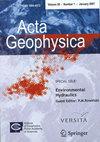First generation of a three-dimensional tomographic model for the uppermost mantle beneath the Zagros collision zone—constraints from full-waveform inversion
Abstract
We construct a three-dimensional model of seismic velocity structure beneath the Zagros collision zone by analyzing phase measurements of seismic waveform recordings from earthquakes. We used entire waveforms from 37 earthquakes and followed a multi-scale approach for periods between 20 and 80 s. As a starting model, we used the first generation of the Collaborative Seismic Earth Model, applied the adjoint method to compute model gradients, and utilized the Broyden–Fletcher–Goldfarb–Shanno (L-BFGS) optimization algorithm to reconstruct the uppermost mantle seismic velocity structure. The Zagros collision zone consists of the margin of the Arabian platform (the Zagros Fold-and-Thrust Belt) and the margin of the Eurasian plate (the Iranian microplates). The retrieved model reveals a strong shear wave velocity contrast at a depth of approximately 180 km along the Zagros mountain belt, and topography at the surface is a piece of evidence that the deformation of the transition zone stops along the Zagros. We interpret this as an interaction between the two continental lithospheres that end at this depth. We observe that the sub-crustal lithosphere of the studied region was constructed from relatively high shear velocity structures beneath Central Iran as well as the Lut block at 80–150 km depth and continuity of high-velocity structure throughout the margin of the Arabian lithosphere from 70- to 200-km depth. It explains continental collision caused earlier thickening during the convergence of the Arabian platform toward the northeast. This observation indicates that the lithosphere of Iranian microplates has a relatively warm structure. It also shows the non-uniform distribution of a sharp velocity contrast between this structure and the strong low-velocity structure underlying it, marking the lithosphere and asthenosphere boundary (LAB). Our results locate this boundary at approximately 119-km depth. On the other hand, we observed a thickened and cold lithosphere for the margin of the Arabian lithosphere.



 求助内容:
求助内容: 应助结果提醒方式:
应助结果提醒方式:


